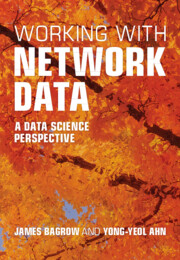Book contents
- Frontmatter
- Contents
- Preface
- Part I Background
- Part II Applications, tools, and tasks
- Chapter 5 The life cycle of a network study
- Chapter 6 Gathering data
- Chapter 7 Extracting networks from data — the “upstream task”
- Chapter 8 Implementation: storing and manipulating network data
- Chapter 9 Incorporating node and edge attributes
- Chapter 10 Awful errors and how to amend them
- Chapter 11 Explore and explain: statistics for network data
- Chapter 12 Understanding network structure and organization
- Chapter 13 Visualizing networks
- Chapter 14 Summarizing and comparing networks
- Chapter 15 Dynamics and dynamic networks
- Chapter 16 Machine learning
- Interlude — Good practices for scientific computing
- Part III Fundamentals
- Conclusion
- Bibliography
- Index
Chapter 15 - Dynamics and dynamic networks
from Part II - Applications, tools, and tasks
Published online by Cambridge University Press: 06 June 2024
- Frontmatter
- Contents
- Preface
- Part I Background
- Part II Applications, tools, and tasks
- Chapter 5 The life cycle of a network study
- Chapter 6 Gathering data
- Chapter 7 Extracting networks from data — the “upstream task”
- Chapter 8 Implementation: storing and manipulating network data
- Chapter 9 Incorporating node and edge attributes
- Chapter 10 Awful errors and how to amend them
- Chapter 11 Explore and explain: statistics for network data
- Chapter 12 Understanding network structure and organization
- Chapter 13 Visualizing networks
- Chapter 14 Summarizing and comparing networks
- Chapter 15 Dynamics and dynamic networks
- Chapter 16 Machine learning
- Interlude — Good practices for scientific computing
- Part III Fundamentals
- Conclusion
- Bibliography
- Index
Summary
Some networks, many in fact, vary with time. They may grow in size, gaining nodes and links. Or they may shrink, losing links and becoming sparser over time. Sitting behind many networks are drivers that change the structure, predictably or not, leading to dynamic networks that exhibit all manner of changes. This chapter focuses on describing and quantifying such dynamic networks, recognizing the challenges that dynamics bring, and finding ways to address those challenges. We show how to represent dynamic networks in different ways, how to devise null models for dynamic networks, and how to compare and contrast dynamical processes running on top of the network against a network structure that is itself dynamic. Dynamic network data also brings practical issues, and we discuss working with date and time data and file formats.
Keywords
- Type
- Chapter
- Information
- Working with Network DataA Data Science Perspective, pp. 235 - 250Publisher: Cambridge University PressPrint publication year: 2024

